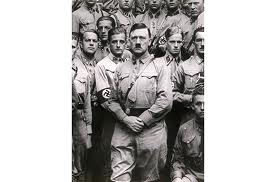- The Nazi Party was formed in 1919
- Hitler joined the party shortly after it’s inception
- Germany was in a state of disarray after the First World War
- There were many extremist groups in Germany at the time
1919-1923
- Many Germans were disillusioned after the defeat in the First World war. Ex-soldiers felt that they had been
 ‘Stabbed in the back’ and felt that they had not been defeated on the battlefield.Many of them joined Right Wing groups such as the Freikorps or the Nazi party.
‘Stabbed in the back’ and felt that they had not been defeated on the battlefield.Many of them joined Right Wing groups such as the Freikorps or the Nazi party. - The Spartacist rising, amongst others, led to many people fearing a Communist revolution in Germany. People looked to right Wing groups to act against this: the Freikorps in particular.
- Economic hardship was coupled with humiliation as a result of the terms of the Treaty of Versailles. Right Wing groups gained popularity by saying that they would not adhere to it’s terms.
How did the Nazi party gain support in this period?
- Military uniforms demonstrated strength at a time when the government was weak
- Use of force against communists and Trade unionists was popular with businesses
- Populist policies and rhetoric were employed to discredit opponents and develop support.
- References to traditional values and reminders of ‘Who was to blame’ for the economic crisis builds support.
1923: Violent uprising
- By 1923 the Nazi party had gained much support in Bavaria. Now firmly under the control of Adolf Hitler the group attempts to seize control of the government through use of force.
- Despite having many sympathisers the coup fails and Hitler is imprisoned.
- The failure of the Beer Hall Putsch demonstrates that power needs to be taken through legal means.
Regrouping
- Whilst in prison Hitler analyses the parties strategy
- Political Strategies are developed and refined
- Shift to winning electoral support
- Development of propaganda tools
- Attempts to win support of big business
1924-1929
- Focus on traditional values
- Builds fear of Left Wing groups
- Continued use of military imagery
- Lack of electoral support due to relative prosperity in Germany at the time
1929-1932: A Change in Fortunes
- Wall Street Crash leads to end of effective financial assistance from USA
- Unemployment rises rapidly
- Hyperinflation recurs
- Threat of Communism increases
- Coalition government fails to address problems successfully
Into government
- Nazi’s use force to prevent uprisings
- Rhetoric plays on peoples fears
- Big Business won over through radical economic plans
- Emphasis placed on military power wins support of many soldiers and traditionalists.
- Weak coalition governments enables Nazi’s to gain political strength
- Propaganda and shows of might impress the masses
- Electoral support rises: Nazi’s become largest single party in the Reichstag
- Continuing economic crisis leads to break down of coalitions
- Aging and ineffective president increasingly reliant upon Article 48
- Germany in desperate need of a strong leader
In Power
- Invited to become chancellor by politicians who believe that Hitler can be manipulated easily
- President Hindenburg’s death allows Hitler to assume presidential powers
- Nazi Party’s rise to power is complete

